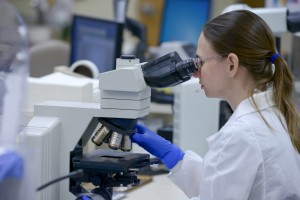-
Researchers decode molecular action of combination therapy for a deadly thyroid cancer
 JACKSONVILLE, Fla. — In their bid to find the best combination of therapies to treat anaplastic thyroid cancer (ATC), researchers on Mayo Clinic’s Florida campus demonstrated that all histone deacetylase (HDAC) inhibitors are not created equal.
JACKSONVILLE, Fla. — In their bid to find the best combination of therapies to treat anaplastic thyroid cancer (ATC), researchers on Mayo Clinic’s Florida campus demonstrated that all histone deacetylase (HDAC) inhibitors are not created equal.
In testing multiple HDAC inhibitors in combination with the chemotherapy drug paclitaxel, known to give some benefit for this aggressive cancer, they found that class II HDAC inhibitors signal through a newly discovered pathway to promote synergy with chemotherapy treatment.
Journalists: Sound bites with Dr. Copland are available in the downloads.
MEDIA CONTACT: Kevin Punsky, Mayo Clinic Public Affairs, 904-953-0746, punsky.kevin@mayo.edu
They say their study, published online today in Endocrine Related Cancers, provides some surprising findings about HDAC inhibitors, which all seemingly do the same thing — remove the HDAC enzymes that wrap DNA so tightly that genes are silenced. There are 11 known HDACs. Blocking HDAC allows the genes to unwind, opening up like a toy Slinky to become active.
“Physicians and researchers should know that just using any of the many approved HDAC inhibitors for a patient’s cancer may not offer the results one wants to see,” says co-author Robert Smallridge, M.D., an endocrinologist who treats thyroid cancer. “That appears to be the case in ATC, and it is probably likely true in a number of cancers.”
The Mayo team has long sought to understand ATC at a molecular level to find treatments that offer longer survival.
“Although ATC is rare – accounting for only 1-2 percent of thyroid cancers, it is responsible for up to 50 percent of thyroid cancer deaths,” says John Copland, Ph.D., a cancer biologist and the study’s senior author.
The mortality rate for ATC nears 100 percent. Diagnosis to death can be measured in weeks to months. When ATC is found early, it is treated aggressively, and patients can survive for a number of years.
“I doubt a single drug will ever work in this cancer, so it is a matter of finding which drugs in combination are going to be most effective,” says Dr. Smallridge.
Even as he leads a national clinical trial testing a combination of paclitaxel chemotherapy with an experimental agent known as efatutazone, Dr. Smallridge is working with Dr. Copland and researcher Laura Marlow to find an HDAC inhibitor that might offer additional benefit.
HDAC inhibitors have been approved for use in blood cancers and are being tested for benefit in other cancers, such as breast, colorectal, gastric, liver, lung and prostate cancers that overexpress specific HDAC proteins.
“HDAC inhibitors can increase activity of RhoB, a tumor suppressor that we had discovered earlier, that is switched off in ATC,” says Dr. Copland. “We also know that this RhoB pathway, once turned on, can stimulate the expression of two proteins: p21, which prevents cells from replicating, and BIM, which induces cell death — both of which can help stop cancer growth.”
Marlow, the laboratory manager in Dr. Copland’s lab, led the study by testing whether different HDAC drugs work with paclitaxel to turn on RhoB, and what effect they had on p21 and BIM.
Marlow found that only HDAC inhibitors that increase expression of BIM work with paclitaxel. And, there were two agents in their study that did that: vorinostat and belinostat. Both are class II HDAC inhibitors. She discovered that HDAC6 is specifically suppressed leading to an increase in RhoB, and BIM is preferentially expressed due to RhoB’s re-expression. They also showed that HDAC6 is overexpressed in patient ATC tissues, indicating that class II HDAC inhibitors will be effective in patients.
She also found that class I HDAC inhibitors suppress HDAC1, which mostly upregulates p21 and sometimes BIM, but to a lesser degree. When p21 is produced, no synergy occurs with paclitaxel; therefore, there is no benefit of adding the HDAC inhibitor to treatment.
“Only vorinostat and belinostat always induced the BIM protein, always induced cell death, and always showed synergy with paclitaxel,” Marlow says.
That suggests that patient ATC biopsies should be examined before an HDAC inhibitor is used with chemotherapy to see whether p21 or BIM protein are being produced in the tumor during treatment, Dr. Smallridge says. Thus, BIM upregulation and protein expression should predict a response to therapy and synergy of the two drugs, he says.
Dr. Copland says that the study shows that molecular work decoding cancer signaling pathways and the effect of agents on those pathways is possible — and necessary. “We now know which of the many HDAC inhibitors to try with ATC,” he says. “It makes sense that similar investigations would help other researchers who want to use an HDAC inhibitor to treat specific cancers.”
Ilah Bok, a technician in Dr. Copland’s lab, also contributed to the research.
This work was supported by the National Institute of Health and Medical Research (R01CA136665); the Florida Department of Health Bankhead-Coley Cancer Research Program (FL09B202); Alfred D. and Audrey M. Petersen; the Francis and Miranda Childress Foundation Fund for Cancer Research; John A. and Bette B. Klacsmann Fund for Cancer Research on Mayo Clinic’s Florida campus; and the Betty G. Castigliano Fund in Cancer Research Honoring S. Gordon Castigliano, M.D., cancer research on the Florida campus.
About Mayo Clinic
Mayo Clinic is a nonprofit organization committed to medical research and education, and providing expert, whole-person care to everyone who needs healing. For more information, visit mayoclinic.com or newsnetwork.mayoclinic.org.
###







